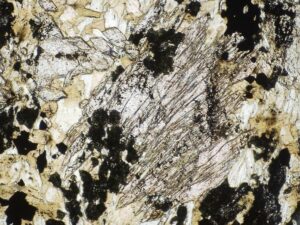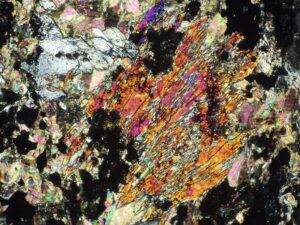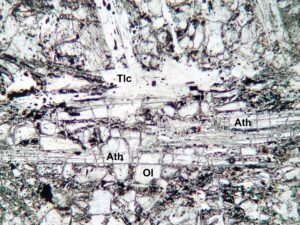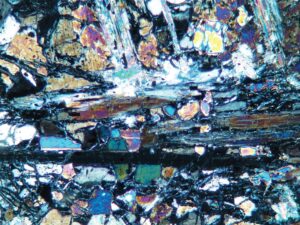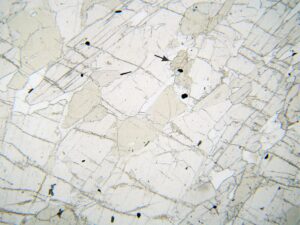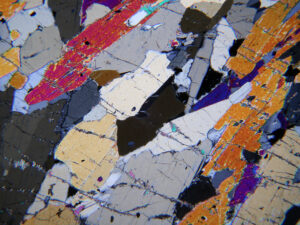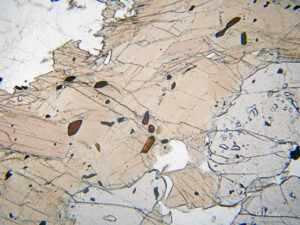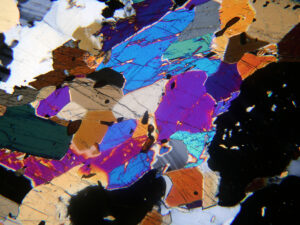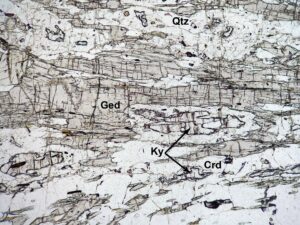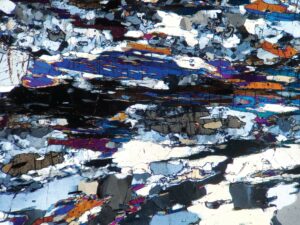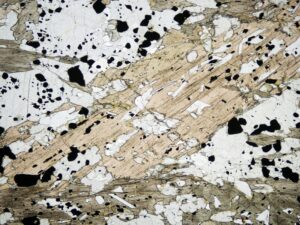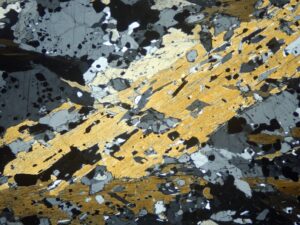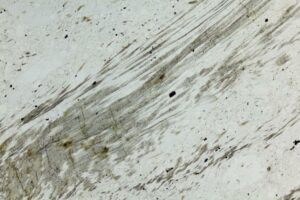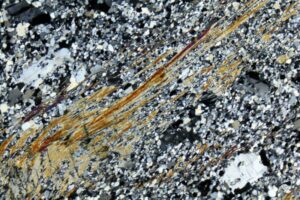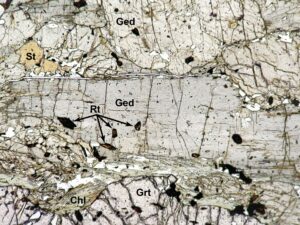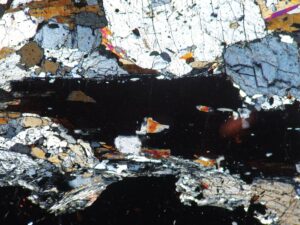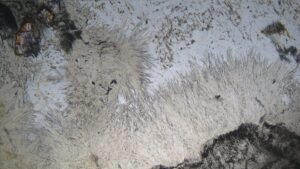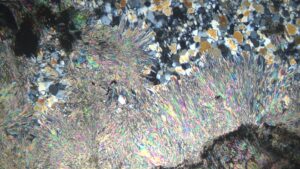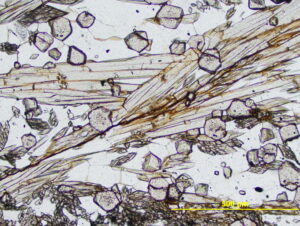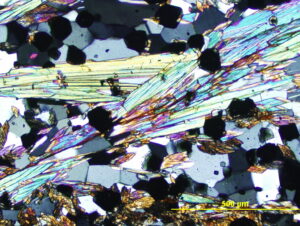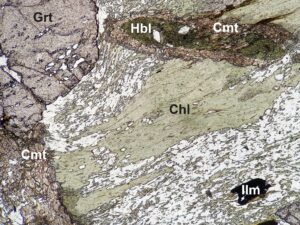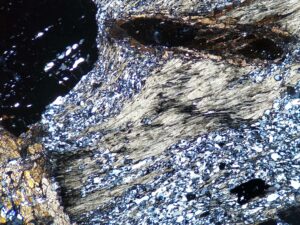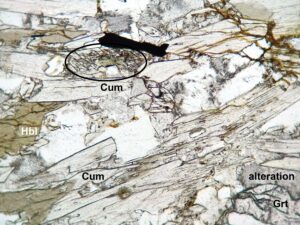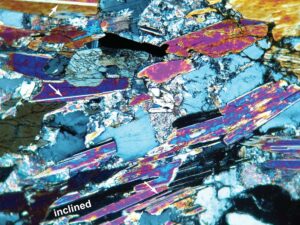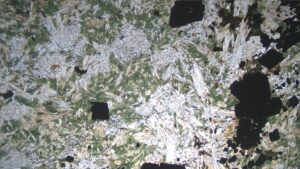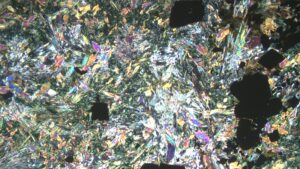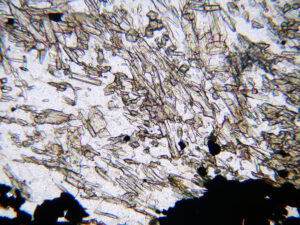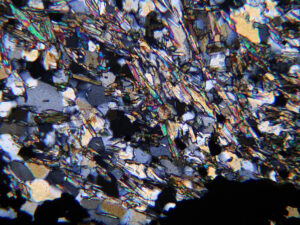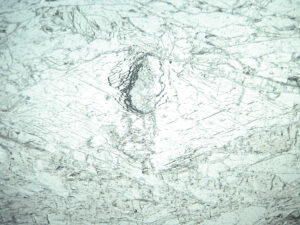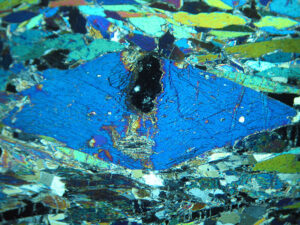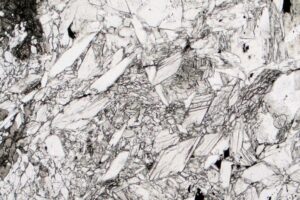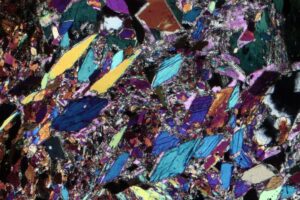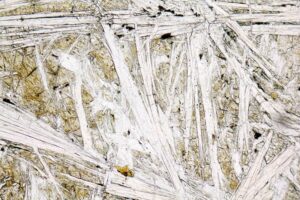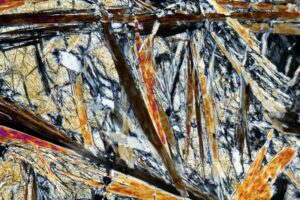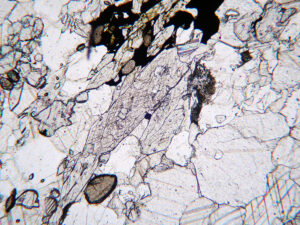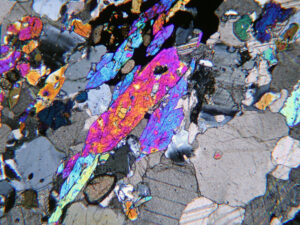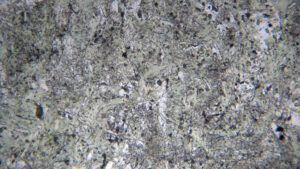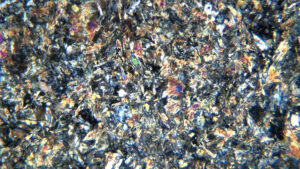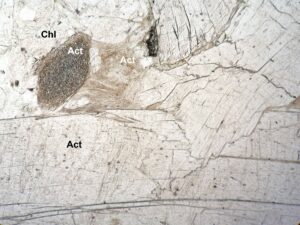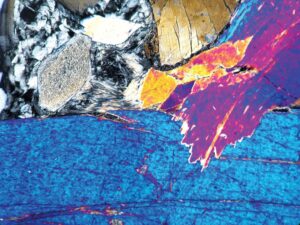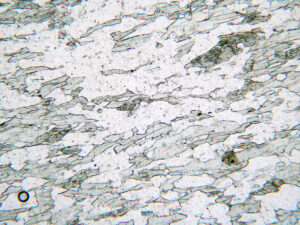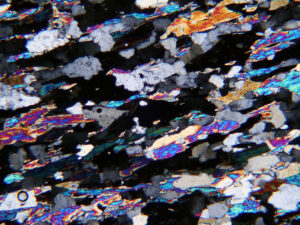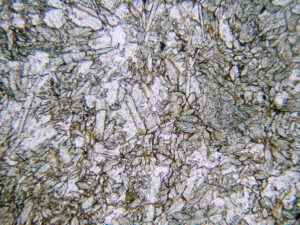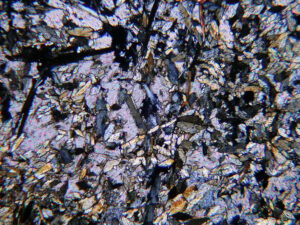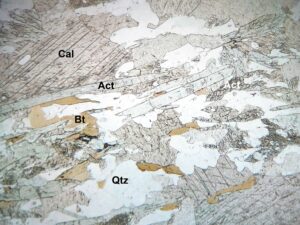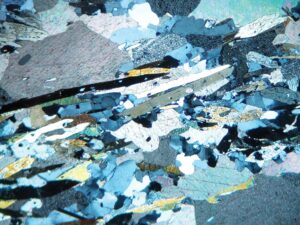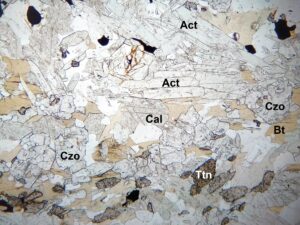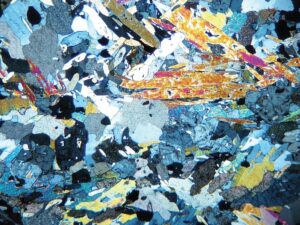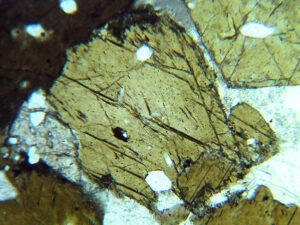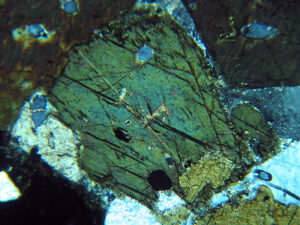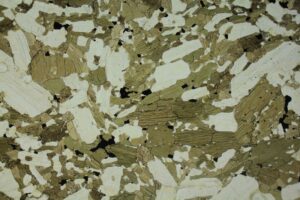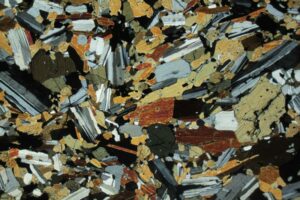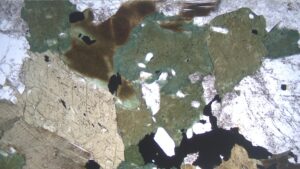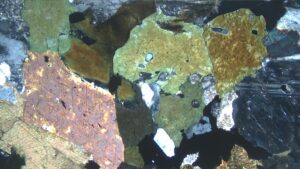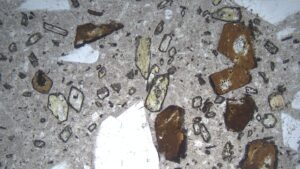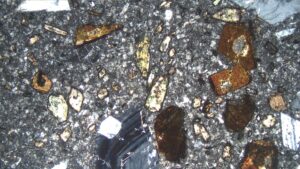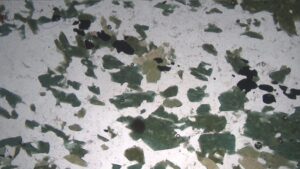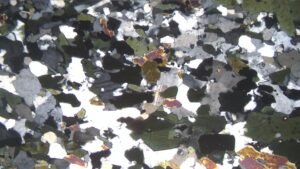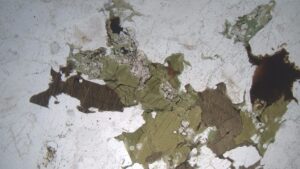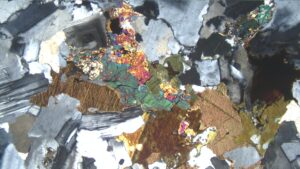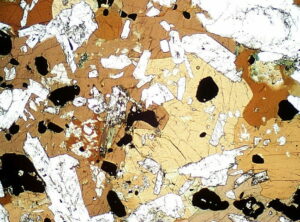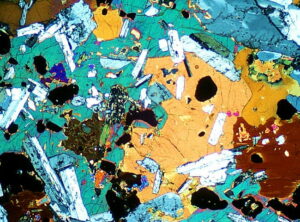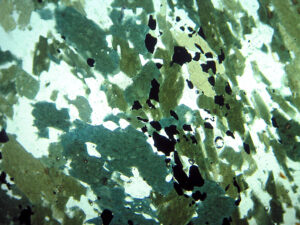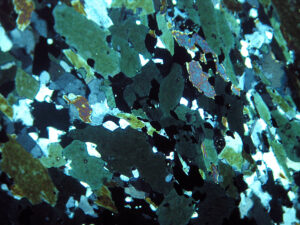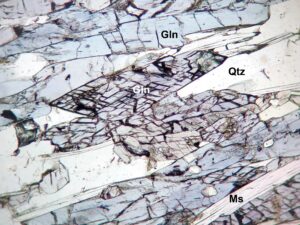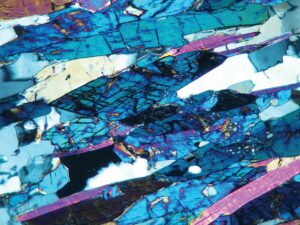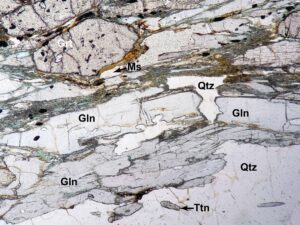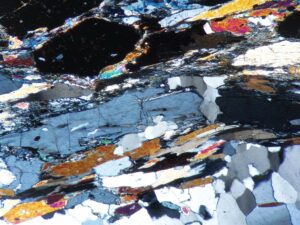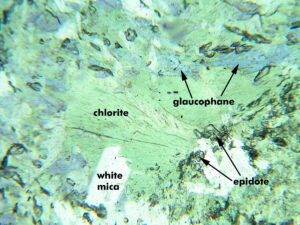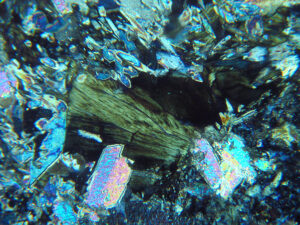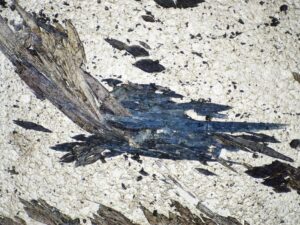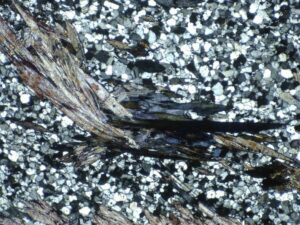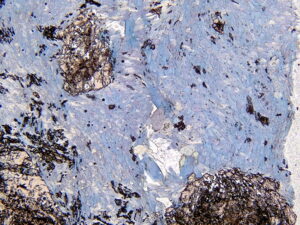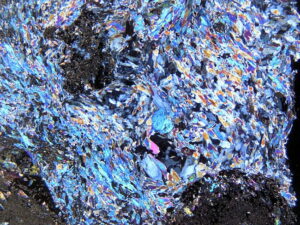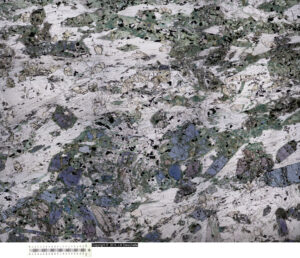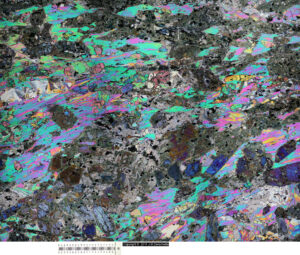Like the pyroxenes, some amphiboles are orthorhombic, others are monoclinic.
Orthorhombic amphiboles are relatively uncommon, but two important ones are:
- anthophyllite – (Mg,Fe)7Si8O22(OH)2
- gedrite – ~Na0.5(Mg,Fe)6Al(Al1.5Si6.5)8O22(OH)2
Monoclinic amphiboles are as common as dirt. The most important include:
- hornblende – (K,Na)0-1(Ca,Na,Mg)2(Mg,Fe,Al)5(Si,Al)8O22(OH)2
- tremolite-actinolite series – Ca2(Mg,Fe)5Si8O22(OH)2
- cummingtonite-grunerite series – (Mg,Fe)7Si8O22(OH)2
- glaucophane-riebeckite series – Na2(Mg,Fe)3(Al,Fe3+)2Si8O22(OH)2
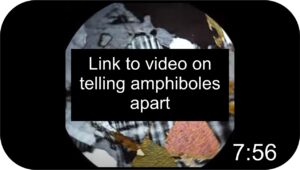 Distinguishing the different amphiboles in thin section can be challenging, but there are some straightforward workflows. The YouTube video linked here gives an overview. In particular, low-Fe amphiboles (anthophyllite, Fe-poor gedrite, tremolite, cummingonite) are colorless in plane-polarized (PP) views. The other Fe-rich amphiboles have more color, typically green, brown, or blue, and are generally pleochroic, although it can be subtle. Additionally, the orthorhombic amphiboles exhibit parallel extinction, whereas monoclinic amphiboles have inclined extinction. Beyond these features, association with different minerals in different kinds of rocks aids identification.
Distinguishing the different amphiboles in thin section can be challenging, but there are some straightforward workflows. The YouTube video linked here gives an overview. In particular, low-Fe amphiboles (anthophyllite, Fe-poor gedrite, tremolite, cummingonite) are colorless in plane-polarized (PP) views. The other Fe-rich amphiboles have more color, typically green, brown, or blue, and are generally pleochroic, although it can be subtle. Additionally, the orthorhombic amphiboles exhibit parallel extinction, whereas monoclinic amphiboles have inclined extinction. Beyond these features, association with different minerals in different kinds of rocks aids identification.
5.1 Anthophyllite – Gedrite
(Mg,Fe)7Si8O22(OH)2 (anthophyllite) – ~Na0.5(Mg,Fe)6Al(Al1.5Si6.5)8O22(OH)2 (gedrite)
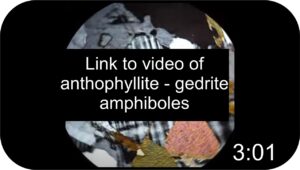 Occurrence—Anthophyllite and gedrite occur primarily in low- to medium-grade Mg-rich metamorphic rocks. Anthophyllite is also common in serpentinites.
Occurrence—Anthophyllite and gedrite occur primarily in low- to medium-grade Mg-rich metamorphic rocks. Anthophyllite is also common in serpentinites.
Anthophyllite has composition (Mg, Fe)7Si8O22(OH)2 with Mg>Fe; if Fe>Mg, it’s called ferro-anthophyllite, but this mineral is even rarer than anthophyllite (which is already pretty rare!). Gedrite is like an aluminous anthophyllite with a little Na thrown in.
Anthophyllite and gedrite are orthorhombic.
Distinguishing Features—Anthophyllite is colorless in thin section, and gedrite is pleochroic gray, gray-green, or tan, to nearly colorless. Both have moderate- to high-relief and display up to low 2nd-order colors. Long prismatic crystals have diamond-shaped cross sections displaying amphibole cleavage with intersecting angles of 55° and 125°; longitudinal sections show only one cleavage.
Orthoamphiboltes commonly occur as long prisms or fibers; anthophyllite is sometimes asbestiform. Because they are orthorhombic, extinction is parallel to their long direction. Distinguishing between anthophyllite and nonpleochroic or weakly pleochroic gedrite can be difficult without chemical analyses.
Similar Minerals—Anthophyllite resembles tremolite and cummingtonite but the latter two are monoclinic and have oblique extinction. Cummingtonite also often has a few polysynthetic twins, which most other amhiboles lack. Zoisite has higher relief and lower birefringence. Gedrite is very similar to anthophyllite but is usually pleochroic gray, not colorless.
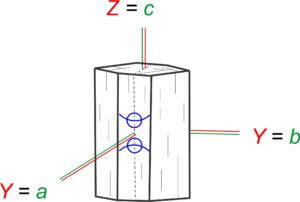
Optical Properties
■■ Orthorhombic; biaxial (+) or (-)
■■ 2V = 65° to 90°
■■ α = 1.598-1.647, β = 1.616-1.651, γ = 1.623-1.664
■■ δ = 0.017-0.026
■■ Parallel extinction in longitudinal sections; symmetrical extinction in cross sections.
| Fig 5.1.1 Metabasite
The PP view shows mostly colorless anthophyllite, including a large grain in the center of the view, and opaque magnetite. In XP, the anthophyllite displays up to high 1st-order interference colors. Photos from the Oxford Earth Sciences Image Store. FOV = 2 mm. |
Fig 5.1.2 Altered Peridotite
This altered ultramafic rock consists mostly of high-relief colorless olivine that has been overprinted twice – first with moderate-relief colorless needles of anthophyllite that cut across olivine grains, and later by moderately low-relief colorless talc that rims both olivine and anthophyllite (PP). In XP, anthophyllite shows parallel extinction and 1st-order interference colors, talc shows 3rd-order colors, and olivine shows bright 2nd-order colors. The opaque mineral is probably magnetite. The origin of this rock is unknown. FOV = 1.4 mm. |
| Fig 5.1.3 Orthoamphibolite
In PP, the orthoamphibole crystals in this image vary in color from pale beige to colorless revealing the pleochroic range. The light colors suggest that the orthoamphibole is not far from anthophyllite in composition. Some low-relief colorless plagioclase makes up most of the rest of the rock. There are a few opaque grains and some muscovite that appears to be an alteration mineral occurring along fractures. Most of the amphibole grains are aligned with their c-axis in the plane of the thin section, so most grains show only one cleavage. There is one grain (marked with an arrow) in the upper-center that has a near-vertical c-axis and shows both cleavages. This rock comes from the Tobacco Root Mountains, Montana. FOV = 5 mm. |
Fig 5.1.4 Orthoamphibole-Garnet Gneiss
The central part of this image is a band of red-brown orthoamphibole crystals dotted with honey-colored rutile grains. The rutile grains are rimmed with opaque ilmenite. Higher-relief pink garnet porphyroblasts fill much of the right side and bottom of the view. Colorless low-relief plagioclase with faint twinning visible in XP completes the picture. The darker color of the orthoamphibole indicates that it is closer to gedrite than anthophyllite in composition. This rock comes from the Ruby Mountains, Montana. FOV = 5 mm. |
| Fig 5.1.5 Gedrite Amphibolite
This amphibolite from eastern Nepal contains typical moderate relief, light gray, pleochroic gedrite, together with colorless low relief quartz, high relief, colorless kyanite, and tiny dark grains of rutile (PP). One, or maybe two, very small brwon flakes of biotite can barely be seen. The kyanite has a reaction rim of low relief colorless cordierite (PP). Many gedrite-rich amphibolites also contain other aluminous minerals, especially staurolite, kyanite, and cordierite. In XP, gedrite shows parallel extinction and intense, uppermost 1st order interference colors. Kyanite has low 1st order yellow interference colors, and quartz and cordierite have 1st order gray to white colors. FOV = 3 mm. |
Fig 5.1.6 Gedrite Gneiss
In this view, unusual brownish to green gedrite is surrounded by colorless quartz and opaque magnetite (PP). The gedrite displays 1st-order yellow to orange interference colors; the quartz has 1st-order gray and white interference colors (XP). Photos from the Oxford Earth Sciences Image Store. FOV = 6 mm. |
| Fig 5.1.7 Gedrite Aplite
This metamorphosed aplite (type of granite) from Dalarna County, Sweden, contains wispy fibers of gray to slightly greenish gedrite (PP). In XP, the gedrite shows 1st-order yellow and orange colors. The surrounding material is almost entirely fine-grained quartz, but twinning in a few larger crystals diagnoses feldspar. Photos from www.alexstrekeisen.it. FOV = 2mm. |
Fig 5.1.8 Gedrite Amphibolite
Moderate-relief, light-gray gedrite dominates this amphibolite from eastern Nepal. The rock also contains high-relief, slightly pinkish garnet, high-relief yellow-orange staurolite, low-relief colorless quartz, and (near the garnet), brown biotite and pale green chlorite (PP). The large gedrite crystals towards the top and right of the image show good amphibole cleavage. Rutile forms many tiny amber-colored crystals, mostly as inclusions in gedrite and garnet. In XP, gedrite shows parallel extinction for a horizontal grain and low 1st-order yellow to white colors for end sections. Garnet is isotropic, staurolite shows 1st-order orange colors, quartz is 1st-order white and gray, biotite has 2nd-order colors and birds eye texture, and chlorite is has anomalous gray-green interference colors. Rutile’s intense color masks its high-order interference colors. FOV = 3 mm. |
5.2 Cummingtonite – Grunerite
Mg7Si8O22(OH)2 (cummingtonite) – Fe7Si8O22(OH)2 (grunerite)
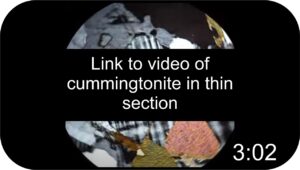 Occurrence—Cummingtonite and grunerite form a complete solid solution between Mg and Fe end members. Cummingtonite has Mg>Fe, whereas grunerite has Fe>Mg. These amphiboles are found in some Si-rich volcanic rocks but are mostly found in metamorphosed igneous rocks where they commonly occur with hornblende. Grunerite is also found in metamorphosed Fe-rich sediments, including banded iron formations. Cummingtonite is essentially a monoclinic version of anthophyllite, although with a little more Fe.
Occurrence—Cummingtonite and grunerite form a complete solid solution between Mg and Fe end members. Cummingtonite has Mg>Fe, whereas grunerite has Fe>Mg. These amphiboles are found in some Si-rich volcanic rocks but are mostly found in metamorphosed igneous rocks where they commonly occur with hornblende. Grunerite is also found in metamorphosed Fe-rich sediments, including banded iron formations. Cummingtonite is essentially a monoclinic version of anthophyllite, although with a little more Fe.
Distinguishing Features—Cummingtonite is colorless to pale tan or gray in thin section; grunerite may be weakly colored in green or yellow. Both show moderate to high relief and 2nd-order to lower 3rd-order interference colors.
These minerals often occur as parallel or radiating aggregates of long prismatic crystals or fibers with diamond shaped cross-sections (e.g., Fig 5.2.2). They show amphibole cleavage, and may display polysynthetic twinning. Some crystals contain exsolution lamellae of hornblende.
Similar Minerals—Anthophyllite is also colorless, but cummingtonite has inclined extinction and (often) polysynthetic twins. Actinolite, another pale-green amphibole, is biaxial (-), typically more deeply and differently colored, and has lower relief than grunerite. Chrysotile has much lower relief and birefringence than these amphiboles. Tremolite is also colorless, but has lower relief and lower birefringence, and it occurs in very different rock types (typically calc-silicates, not metavolcanics). Distinguishing cummingtonite from grunerite may require chemical analysis, but cummingtonite is optically positive, while grunerite is optically negative.
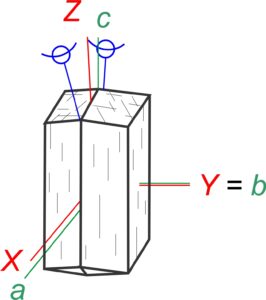
Optical Properties
■■ Monoclinic; cummingtonite is biaxial (+), grunerite is biaxial (-)
■■ 2V = 80° to 90°; α = 1.644-1.685, β = 1.657-1.709, γ = 1.614-1.728
■■ δ = 0.030-0.043
■■ Maximum extinction angle varies from about 10° to 20° in longitudinal sections, depending on composition
| Fig 5.2.1 Cummingtonite Schist
This schist from Leeds, South Dakota, contains radiating clusters of cummingtonite with low relief, colorless quartz, and a few somewhat altered, but pinkish, high relief garnets (upper left) (PP). The cummingtonite shows a variety of pastel 2nd-order interference colors. The quartz displays up to 1st- order yellow/orange colors, indicating this thin section is too thick. The garnets are isotropic. FOV = 3.5 mm. |
Fig 5.2.2 Cummingtonite Schist
This spectacular schist from Cummington, Massachusetts, (the type locality of cummingtonite!) contains both blades and end views of moderate-relief cummingtonite with low-relief colorless quartz, and small, high-relief pinkish garnets (PP). The end views of cummingtonite appear as diamonds with two very well-developed cleavages and 1st-order interference colors. Elongate grains show up to 2nd-order blue, green, and yellow interference colors (XP). The garnet is isotropic, and the quartz displays 1st-order gray and white colors (XP). Photos from science.smith.edu. FOV = 3.5 mm. |
| Fig 5.2.3 Cummingtonite Schist
Tan, moderate-relief cummingtonite forms a separate grain in the lower left. It also is seen as rims on dark-green, moderate-relief hornblende in this metavolcanic rock from the Tauern Window, Austria (PP). Other minerals include high-relief, pinkish garnet, pale-green chlorite, black ilmenite, and low-relief, colorless, fine-grained quartz and feldspar. In XP, cummingtonite has 1st-order yellow to orange color, with mottling that reflects twins. Hornblende is nearly extinct, while chlorite is anomalous with 1st-order gray-green colors. Quartz and plagioclase are characteristically 1st-order gray to white. FOV = 3 mm. |
Fig 5.2.4 Garnet Amphibolite
This amphibolite from Montana contains both moderate-relief colorless to tan cummingtonite and moderate-relief greenish brown hornblende. Other minerals include low-relief colorless plagioclase and quartz, and high-relief, slightly pinkish garnet (lower right; PP). One end section of a cummingtonite grain has a hornblende core and shows amphibole cleavage (circled). In XP, cummingtonite shows twinning (arrows), inclined extinction (labeled for one grain), and uppermost 1st-order to lower 2nd-order interference colors. Garnet is isotropic, quartz and plagioclase are 1st-order gray to white, and hornblende’s deep color masks its interference colors. Some plagioclase is altered to fine-grained clay or white mica (or both) either pervasively or along fractures. FOV = 1.6 mm. |
| Fig 5.2.5 Metamorphosed Iron Formation
This rock from Michigamme, Michigan, contains blades of colorless grunerite, some in radiating clusters, that has been replaced in many places by green chlorite (PP). In XP, the grunerite displays upper 2nd-order interference colors, and the chlorite display anomalous 1st-order olive-green colors. There is also considerable magnetite (opaque) in this rock. FOV = 3.5 mm. |
Fig 5.2.6 Metamorphosed Banded Iron Formation
This is a 3-mineral rock. A layer of prismatic, greenish grunerite is surrounded by lower-relief quartz, and is next to a layer of opaque magnetite. The thin section is slightly thick as revealed by the yellow interference colors of some of the quartz grains. FOV = 1.25 mm. |
5.3 Tremolite
Ca2Mg5Si8O22(OH)2
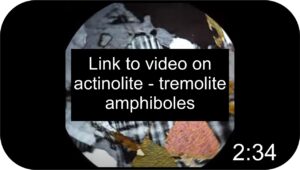 Occurrence— Tremolite has composition close to end-member Ca2Mg5Si8O22(OH)2 but some Fe may substitute for Mg. It occurs in low- to medium-grade metamorphic rocks that have a high CaO content, especially in marbles, calc-silicates, and in some metamorphosed ultramafic rocks.
Occurrence— Tremolite has composition close to end-member Ca2Mg5Si8O22(OH)2 but some Fe may substitute for Mg. It occurs in low- to medium-grade metamorphic rocks that have a high CaO content, especially in marbles, calc-silicates, and in some metamorphosed ultramafic rocks.
Distinguishing Features—Occurrence in marbles and other rocks with carbonates is one key identifying characteristic. Tremolite is colorless in thin section, typically occurring as moderate- to high-relief parallel or radiating aggregates of long prismatic crystals, blades, or fibers.
End sections show the two amphibole cleavages that intersect at 56° and 124°. Only one cleavage is seen in a longitudinal section.
Polysynthetic twinning may be present.
Tremolite displays 2nd-order to lower 3rd-order interference colors. It is biaxial negative with a 2V of about 85o.
Similar Minerals—Tremolite is generally colorless with no pleochroism. This distinguishes it from most other amphiboles. Anthophyllite is also colorless but has parallel extinction. (Tremolite has inclined extinction).
Tremolite is distinguished from wollastonite and diopside by its amphibole cleavage. Actinolite is typically more deeply colored, and has lower relief than tremolite. Chrysotile has much lower relief and birefringence. Cummingtonite may be difficult to distinguish from tremolite but is typically polysynthetically twinned and can be light tan to gray.
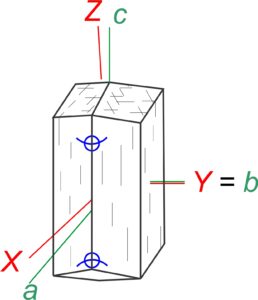
Optical Properties
■■ Monoclinic; biaxial (-)
■■ 2V = 80° to 90°
■■ α = 1.644-1.685, β = 1.657-1.709, γ = 1.614-1.728
■■ δ = 0.030-0.043
■■ Maximum extinction angle varies from about 10° to 20° in longitudinal sections, depending on composition.
| Fig 5.3.1 Tremolite Marble
In this marble from the Adirondack Mountains, New York, almost all of the field of view is an end-section of colorless tremolite (looking down the c-axis), showing the classic amphibole cleavage (PP). Smaller grains around it have their long axes in the plane of the thin section, so they appear as long blade-like crystals. Interference colors are characteristically high (XP). FOV = 2 mm. |
Fig 5.3.2 Tremolite Marble
This rock from the Piedmont region of Italy consists almost entirely of colorless tremolite, here showing many end sections (views down c-axis) but also needles/laths, in a fine grained matrix (PP). Tremolite’s interference colors range up to 2nd-order yellow or orange in the XP view. Photos from www.alexstrekeisen.it. FOV = 7 mm. |
| Fig 5.3.3 Tremolite Needles
This rock from Elba Island, Italy, shows colorless tremolite needles. In XP, tremolite displays unusually low mid- to upper-1st order interference colors, and inclined extinction. FOV = 7 mm. Photos from www.alexstrekeisen.it. FOV = 7 mm. |
Fig 5.3.4 Siliceous Carbonate
This is a carbonate-silicate rock from Acton, Massachusetts. A boundary between a calcite-rich layer (lower-right) and a silicate-rich layer (upper-left) runs diagonally through the center of the image. Tremolite grains dominate the silicate layer. A large, euhedral tremolite crystal shows especially well the telltale amphibole cleavages intersecting at 60° and 120°. The silicate layer also contains low-relief colorless grains of microcline, and brownish high-relief titanite crystals with opaque ilmenite overgrowths that are visible in PP. Calcite (lower right) is identified by its beige (very high-order) interference colors in XP and by the polysynthetic twin lamellae visible for some grains in PP. FOV = 2.5 mm |
| Fig 5.3.5 Tremolite Needles
This rock from Elba Island, Italy, contains colorless tremolite needles. In XP, tremolite shows unusually low mid- to upper-1st order interference colors, and inclined extinction. FOV = 7 mm. Photos from www.alexstrekeisen.it. FOV = 7 mm. |
5.4 Actinolite
Ca2(Fe,Mg)5Si8O22(OH)2
 Occurrence—Actinolite is generally found in low-grade mafic metamorphic rocks. It is commonly associated with chlorite and epidote in greenschists. Composition is variable, ranging from 10 to 90% end member Ca2Fe5Si8O22(OH)2. (Tremolite is the name of amphiboles that are nearly pure Ca2Mg5Si8O22(OH)2.)
Occurrence—Actinolite is generally found in low-grade mafic metamorphic rocks. It is commonly associated with chlorite and epidote in greenschists. Composition is variable, ranging from 10 to 90% end member Ca2Fe5Si8O22(OH)2. (Tremolite is the name of amphiboles that are nearly pure Ca2Mg5Si8O22(OH)2.)
Distinguishing Features—Actinolite typically shows distinctive pale yellow-green or slightly blue-green color and pleochroism.
Actinolite crystals are generally elongate – prismatic, columnar, acicular, or fibrous. Parallel or radiating aggregates are common. Relief is medium to high.
End sections show the two amphibole cleavages that intersect at 56° and 124°. Only one cleavage is seen in a longitudinal section.
Polysynthetic twinning may be present, and in some cases actinolite contains exsolution lamellae of hornblende.
Actinolite’s interference colors range from 2nd-order to lower 3rd-order, higher than many other amphiboles.
Similar Minerals—Few minerals have the same color and pleochroism as actinolite. Typical amphibole cleavage and habit further distinguish it. Actinolite’s inclined extinction and pale green color distinguish it from gedrite and anthophyllite, other amphiboles that have parallel extinction and different colors. Cummingtonite is normally colorless, or sometimes light tan to gray, and it has greater tendency to form polysynthetic twins. Additionally, actinolite is biaxial (-). Chrysotile and chlorite have similar color, but has much lower relief and birefringence than actinolite.

Optical Properties
■■ Monoclinic; biaxial (-)
■■ 2V = 65° to 90°
■■ α = 1.599-1.688, β = 1.612-1.697, γ = 1.622-1.705
■■ δ = 0.017-0.027
■■ Maximum extinction angle varies from about 10° to 20° in longitudinal sections, depending on composition
| Fig 5.4.2 Actinolite Schist
This actinolite schist from the Santa Catalina subduction complex, California, contains huge crystals of colorless moderate-relief actinolite, “hairy” fibers of actinolite, and clots of colorless moderately low-relief chlorite (PP). One diamond-shaped end section shows well-developed amphibole cleavage. We know this is not tremolite because the amphibole is green in hand sample. In XP, large crystals of actinolite show up to 2nd-order interference colors, while the fibrous wisps display only 1st-order colors. Chlorite has patchy 1st-order gray and white colors. FOV = 3 mm. |
|
| Fig 5.4.3 Actinolite Calcsilicate
This rock contains pale-green actinolite crystals showing one or two cleavages. It also contains colorless quartz. In XP the actinolite has upper 1st-order red-orange to blue birefringence. The quartz has patchy gray interference colors. FOV = 5 mm |
5.4.4 Actinolite Carbonate
This rock comes from Montana’s Ruby Mountains. The pale green mineral is actinolite. The colorless mineral is calcite. Little else is visible. The actinolite occurs in elongated grains that are in a random orientation. End views of those grains show the two principal amphibole cleavages intersecting at 60° and 120°. In XP, the actinolite displays 1st-order interference colors (up to 1st-order orange, but some colors are anomalous blue). Colors vary depending on orientation of the grain. FOV = 1.25 mm |
| Fig 5.4.5 Calc-silicate
This calc-silicate from Vermont contains large laths of moderate-relief light-green actinolite together with brown biotite, colorless low-relief quartz, and brownish high-relief calcite (PP). The right side of the photo shows end-sections of actinolite with amphibole cleavage. In XP, actinolite displays inclined extinction and 1st-order orange interference colors, biotite shows 2nd-order colors and birds eye texture, quartz is 1st-order gray to white, and calcite is pastel to pearly with a pebbly texture. FOV = 3.5 mm. Sample courtesy of Dr. Frank Spear, Rensselaer Polytechnic Institute. |
5.4.6 Calc-silicate Schist
This calc-silicate from Vermont contains large crystals of moderate-relief, light-green actinolite, together with low-relief colorless quartz (unlabeled), brown biotite, variable-relief calcite with twins, high-relief clinozoisite, and super-high relief, brown titanite (PP). In XP, actinolite has upper 1st-order orange to purple interference colors. Biotite displays 2nd-order colors and birds eye extinction texture, calcite is pastel to pearly, clinozoisite is characteristically 1st-order gray, and titanite is pastel, although its brown color masks this (XP). FOV = 3.5 mm. Sample courtesy of Dr. Frank Spear, Rensselaer Polytechnic Institute. |
5.5 Hornblende
(K,Na)0-1(Ca,Na,Mg)2(Mg,Fe,Al)5(Si,Al)8O22(OH)2
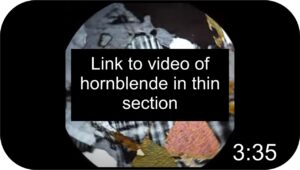 Occurrence—Hornblende is found in a wide variety of igneous and metamorphic rocks.
Occurrence—Hornblende is found in a wide variety of igneous and metamorphic rocks.
Distinguishing Features—Like all amphiboles, hornblende shows moderate- to high-relief in thin section, but unlike others it has deep green or brown (less commonly yellow, blue-green, or red-brown) color and strong pleochroism. Concentric or patchy color zoning may be present. Hornblende’s color, along with characteristic amphibole cleavage and (when present) diamond-shaped cross sections, are generally sufficient for identification.
Interference colors, optic sign, 2V, and other properties are variable due to highly variable composition. For most hornblende, maximum interference colors are about middle 2nd-order, but higher-order colors are possible. The interference colors are often masked by the deep color of the mineral.
Crystals are most commonly subhedral to anhedral. They may appear blocky or prismatic and, less commonly, elongate or fibrous. End sections generally show imperfect diamond-shaped cross sections. Longitudinal sections may appear as laths.
Simple twinning is common. Rarely, hornblende contains exsolution lamellae of other amphiboles.
Similar Minerals—Brownish hornblende can be confused with biotite, but hornblende does not show birds eye extinction and has higher relief and two cleavages compared with biotite’s one. When both brown hornblende and biotite occur together, biotite is often redder (“fox-brown”).
Hornblende can be distinguished from augite by lower relief, amphibole rather than pyroxene cleavage angles, stronger pleochroism, and different optic sign and extinction angle.
Other amphiboles have many similar optical properties, but have different colors. The Na-amphiboles glaucophane, riebeckite, and crocidolite (which is asbestiform riebeckite) have characteristic pleochroic blue or violet colors.
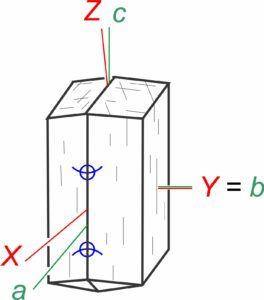
Optical Properties
■■ Monoclinic; biaxial (-)
■■ 2V = 52° to 85°
■■ α = 1.614-1.675, β = 1.618-1.691, γ = 1.633-1.701
■■ δ = 0.019-0.026
■■ In longitudinal sections, the maximum extinction angle varies from about 12° to 30° depending on composition; in cross sections, extinction is symmetrical to the two cleavages.
| Fig 5.5.1 Hornblende
The large grain of hornblende in the center, cut nearly perpendicular to its c-axis, shows typical brown color and amphibole cleavage (PP). Other minerals include high-relief tan calcite (to the left of the hornblende) and low-relief colorless plagioclase (PP). Hornblende’s interference colors are 2nd-order, but masked somewhat by its brown color. Calcite shows high-order pastel interference colors, and plagioclase only 1st-order gray and white colors (XP). FOV ~ 2.5 mm. |
Fig 5.5.2 Hornblende Gabbro
In this hornblende gabbro, hornblende’s greenish- brown color mimics biotite (although no biotite is present). Other minerals are low-relief colorless plagioclase and an opaque that is likely either magnetite or ilmenite. In XP, hornblende lacks bird’s eye extinction and has 1st-order interference colors (distinguishing it from biotite). Plagioclase displays its characteristic gray and white interference colors and polysynthetic twinning. There are no end sections of amphibole in this view to check for amphibole cleavage, but we would look for that elsewhere in the thin section to be sure of our identification. FOV = 7 mm. |
| Fig 5.5.3 Diorite
This diorite from near Azusa, California, contains moderate-relief, mottled pleochroic green to brown hornblende, surrounded by low-relief colorless plagioclase (PP). In XP, hornblende displays upper 1st-order interference colors (masked somewhat by the mineral’s strong color), and plagioclase displays 1st-order grays and white. In PP, the hornblende shows compositional zoning, with browner cores and greener rims; the zoning is somewhat more evident in XP. FOV = 3.5 mm. |
Fig 5.5.4 Dacite
This dacite from near Helena, Montana, contains phenocrysts of high-relief greenish hornblende, moderate-relief brown biotite, and low-relief colorless plagioclase (PP). In XP, the hornblende and plagioclase show 1st-order interference colors, but the biotite’s interference colors are masked by the color of the grains. The largest grain of plagioclase (in the middle of the bottom edge) shows concentric zoning. The fine-grained matrix is likely mostly quartz and feldspar. FOV = 3.5 mm. |
| Fig 5.5.5 Hornblende Gneiss
In this rock, moderate-relief green hornblende is surrounded by abundant low-relief colorless plagioclase and quartz. A few scattered opaque magnetite crystals are also present (PP). In XP, some hornblende shows 2nd-order yellow to purple interference colors, but most colors are masked by the hornblende’s deep-green color. Plagioclase and quartz show their typical gray to white interference colors (XP). FOV = 3.5 mm. |
Fig 5.5.6 Hornblende Gabbro
This gabbro contains moderate-relief, pleochroic, olive-green to brown hornblende, overgrowing high-relief pyroxene. The hornblende and pyroxene are surrounded by low-relief colorless plagioclase (PP). Hornblende commonly replaces pyroxenes through a process called uralitization. In XP, hornblende’s 2nd-order colors are largely masked by its dark brown color. Plagioclase shows its usual 1st-order gray to white interference colors and polysynthetic twinning. FOV = 3.5 mm. |
| Fig 5.5.7 Hornblende gabbro
This gabbro is dominated by moderate-relief, dark- and light-brown hornblende, low-relief, colorless plagioclase, and an opaque that is likely ilmenite or magnetite (or both) (PP). The color of the hornblende mimics biotite, but hornblende has higher relief, lacks bird’s eye extinction in XP, and one or two of the crystals give a hint of hornblende’s characteristic near 60o-120o cleavage angles. Interference colors for hornblende are 2nd-order. Plagioclase shows 1st-order white interference colors and twinning (XP). Photos from Kurt Hollocher. FOV = 6 mm. |
Fig 5.5.8 Hornblende Schist
This schist is mostly pleochroic green hornblende and clear quartz (PP). Black opaque magnetite is also present. In the XP view, the deep color of the hornblende partially masks the interference colors, making them somewhat anomalous. A few of the amphibole grains show two cleavages that intersect at about 60° and 120°. This schist comes from Chester, Vermont. FOV = 2.5 mm. |
5.6 Na Amphiboles (Glaucophane, Riebeckite, Crossite)
Na2(Mg,Fe)3(Al,Fe3+)2Si8O22(OH)2 (glaucophane) – Na2(Fe,Mg)3(Fe3+,Al)2Si8O22(OH)2 (riebeckite)
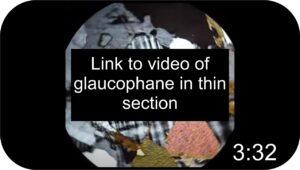 Occurrence—The sodic amphiboles (glaucophane and riebeckite) are often referred to as blue amphiboles because of their characteristic gray-blue colors in hand specimen and thin section. Crossite is the name given to amphiboles intermediate between glaucophane and riebeckite.
Occurrence—The sodic amphiboles (glaucophane and riebeckite) are often referred to as blue amphiboles because of their characteristic gray-blue colors in hand specimen and thin section. Crossite is the name given to amphiboles intermediate between glaucophane and riebeckite.
The main difference between glaucophane and riebeckite is Fe – riebeckite contains substantially more Fe3+ and usually a bit more Fe2+ also. Otherwise, their compositions are quite similar.
Glaucophane is found almost exclusively in high-pressure metamorphosed mafic rocks (blueschists and some eclogites). It also occurs as a retrograde alteration of pyroxenes in (former) eclogites.
Riebeckite can be found in metamorphic rocks, too, but is a diagnostic mineral in many different kinds of intermediate to felsic alkaline igneous rocks, such as alkali granites, syenites, and some alkaline rhyolites. It also occurs in iron formations where it may be asbestiform. Crossite, with composition intermediate between glaucophane and riebeckite, has similar properties and occurrences as riebeckite. Crocidolite is a carcinogenic, asbestiform variety of riebeckite that at one time was used as filters in cigarettes.
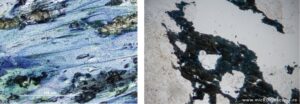
Distinguishing Features—Blue amphiboles are hard to miss in thin section because of their moderate- to high-relief and blue pleochroism. Glaucophane, for example, typically displays characteristic pale blue-to-blue or blue-to-lavender pleochroism. Riebeckite typically displays similar or darker colors. Sometimes the colors are a very dark “inky blue.”
Long slender or prismatic crystals with diamond-shaped cross sections are typical for both glaucophane and riebeckite. Less commonly these minerals may be fibrous, or in columnar aggregates, or in foliated masses.
Both minerals show characteristic amphibole cleavage. When coarse, end sections may be distinctively diamond-shaped with cleavages intersecting at 56° and 124°. Riebeckite, however, is commonly fine-grained and fibrous; end sections may be hard to find.
Maximum interference colors for these amphiboles are middle- to upper-1st order but may be anomalous due to the color of the mineral.
Sodic amphibole is easily identified when it occurs in blueschists with other high-pressure minerals, including muscovite, epidote or lawsonite, garnet, and either rutile or titanite.
Similar Minerals—Different blue amphiboles are difficult to tell apart, and glaucophane and riebeckite form a complete solid solutions series, so properties of these minerals grade into each other. Nonetheless, Fe-rich riebeckite is generally darker, showing dark blue, inky, violet, blue-green, or brown colors. Fe-poor glaucophane is much paler, and truly Mg-rich glaucophane may be nearly colorless.
Glaucophane is biaxial (-). Riebeckite is typically (-) but may be biaxial (+), depending on composition. Glaucophane has a smaller 2V. Glaucophane is length slow, whereas riebeckite is length fast.
Blue amphibole might be confused with blue tourmaline, but tourmaline is uniaxial.
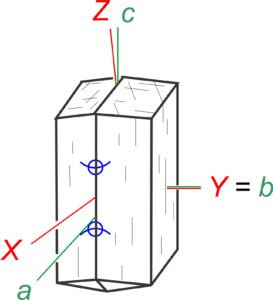
Optical Properties
■■ Monoclinic; glaucophane is biaxial (-), riebeckite is biaxial (+ or -)
■■ 2V = 10° to 45° (glaucophane), 45° to 90° (riebeckite)
■■ α = 1.606-1.701, β = 1.622-1.711, γ = 1.627-1.717 for both
■■ δ = 0.006-0.029
■■ Extinction angle to cleavage is 0 – 6°
■■ Glaucophane is length slow; riebeckite is length fast
| Fig 5.6.1 Blueschist
This glaucophane schist from Syros, Greece, contains abundant crystals of moderate-relief blue to lavender glaucophane, low-relief colorless quartz, and moderate-relief colorless muscovite (PP). The end-section of glaucophane (lavender) shows pronounced amphibole cleavage. Although several minerals can be pleochroic blue, glaucophane is the only common mineral that is also pleochroic lavender. In XP, glaucophane shows inclined extinction and 2nd order colors, quartz is 1st-order gray to white, and muscovite has 3rd-order colors. FOV = 1.4 mm. |
Fig 5.6.2 Blueschist
This blueschist from the western Alps of Italy contains large, moderate-relief, colorless to pale blue-gray prisms of glaucophane, high-relief slightly pink garnet, low-relief colorless quartz, and a few grains of high-relief brown titanite and moderate-relief colorless muscovite (PP). This glaucophane is relatively colorless, typical of more Mg-rich compositions. The very fuzzy material along grain boundaries is probably a mixture of epidote, chlorite, and blue amphibole, but is too fine-grained for definitive identification. In XP, glaucophane shows low 2nd-order colors, garnet is isotropic, quartz is 1st-order gray to white, and muscovite has 2nd-order colors. FOV = 3 mm. |
| Fig 5.6.3 Altered Blueschist
This blueschist comes from near Healdsburg, California. Green chlorite, blue glaucophane, white mica flakes (bottom center and right) and a number of small high-relief epidote grains are visible in the PP view. In XP, the chlorite shows anomalous interference colors, the glaucophane shows only the blue color of the grains, not generally typical of this mineral. The epidote grains are hard to pick out in XP light but the white mica flakes show obvious mottled interference colors typical of micas. FOV = about 2.5 mm. |
Fig 5.6.4 Crossite
These photos show crossite that has formed in a metamorphosed chert. The amphibole is in sheaves, some of which show the characteristic blue amphibole color. The chert (quartz) in the background is clear (PP). In the XP view, we see that the inky color of the crossite masks any interference colors that might be present. The quartz grains appear as quartz normally does. Phtos from the Oxford Earth Sciences Image Store. FOV = 2.5 mm. |
| 5.6.5 Blueschist
This blueschist contains glaucophane that is accompanied by some moth-eaten, high-relief garnets. Glaucophane is characteristically pleochroic in shades of blue and lavendar. Some glaucophane in this view is partially zoned, with pale cores and darker, more Fe3+-rich, rims. As with most monoclinic amphiboles, glaucophane has interference colors in the lower 2nd-order. The colors are, however, somewhat masked by the blue color of the mineral. Photos from Dr. Kurt Hollocher. FOV = 1.2 mm. |
5.6.6 Glaucophane Metavolcanic
This metavolcanic rock comes from near Prasini, Italy. It contains blue glaucophane that is partly altered to green hornblende. The glaucophane is accompanied by abundant white mica and clear high-relief epidote. The epidote is slightly yellow (PP). In the XP view, the glaucophane shows anomalous interference colors, the mica shows high 2nd-order colors, and epidote shows high-order pastels. Some of the clear minerals in the PP view are calcite. The calcite shows characteristic twinning in XP. Small flakes of some opaque mineral are scattered throughout. These photos are from jm-derochette.be. FOV = 7 mm. |
